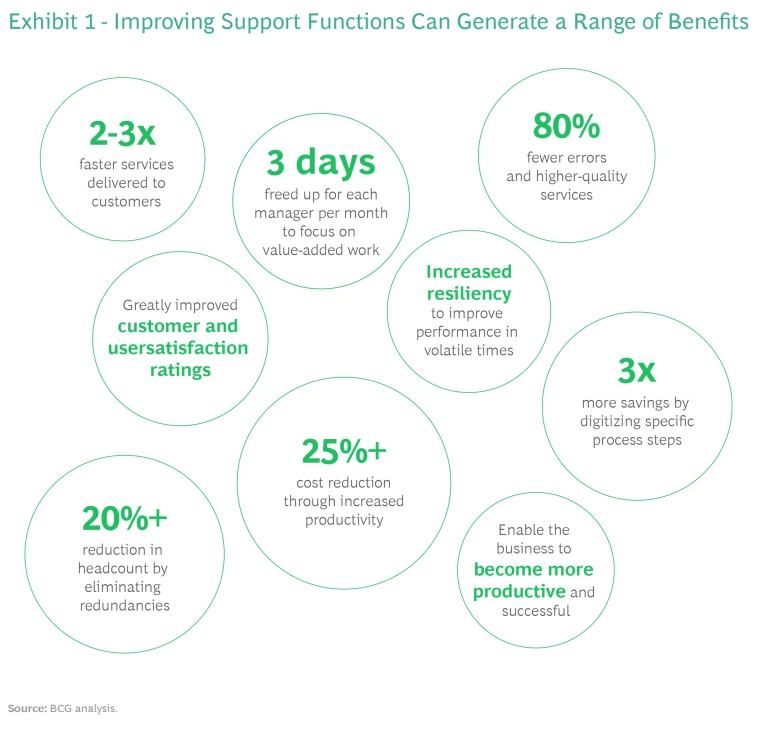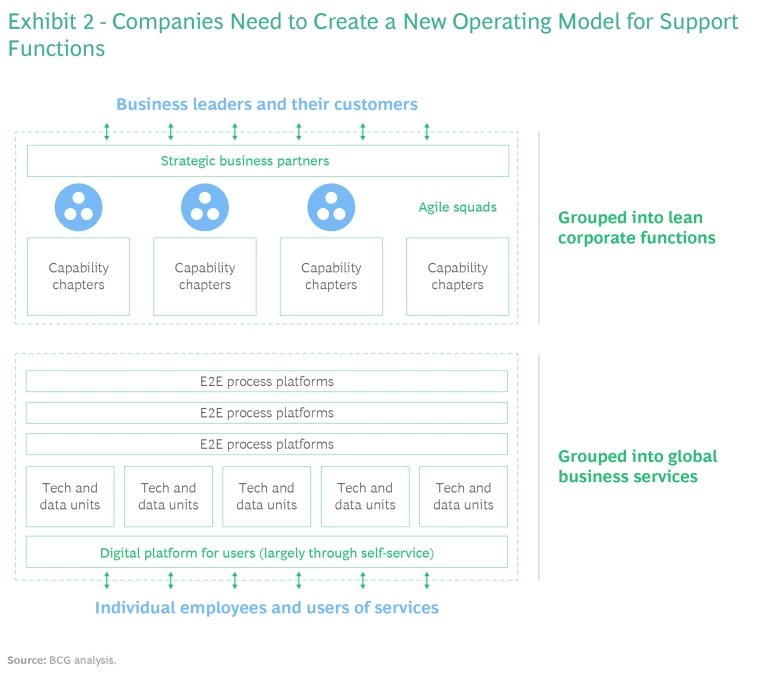Companies are being disrupted by digital technology and other external trends, and they must revamp their business model to become more innovative, customer-centric, agile, and data-powered. Support functions can be important drivers of transformation and value, provided that they improve their own performance to partner more effectively with the business. In that way, improving support functions is a crucial first step that can power a broader enterprise-wide transformation.
Based on our experience, companies that make their support functions more business-centric can unlock a range of benefits in terms of speed, accuracy, efficiency, and—most important—value creation. (See Exhibit 1.) These change efforts can be complex, depending on a company’s starting point, but companies can begin to unlock the benefits through a series of pragmatic, accessible steps. What’s required? Inspirational leadership, new capabilities, and more agile ways of working.

Where Companies Struggle
Most management teams know they can improve their support functions to become more agile and resilient, and many have tried. However, after multiple rounds of standardization and cost-cutting, companies are still plagued by poor services, complex processes, and—fundamentally—an inability to partner with businesses to support changing priorities and needs. These problems share several underlying causes.
- Insufficient business partnerships. Support functions like IT, HR, finance, and procurement often lack a strong mandate in their partnerships with business units. They don’t have a “seat at the table” to understand business priorities, or they lack access to resources needed to achieve those objectives.
- An “ivory-tower” mentality. Topic experts in centers of excellence (CoEs) spend a lot of time and money inventing solutions and tools that no one asked for. For example, they develop one-size-fits-all policies and procedures that are not fit for purpose and add to the administrative burden on the business.
- Cumbersome manual processes. The user experience for internal and external customers can be frustrating, outdated, and unacceptable for digital natives. Business leaders, fed up with slow response times and low quality, create workarounds and shadow functions to regain control over critical business processes.
- Inaccessible data. Support functions often have a wealth of data, which should empower business leaders to make better decisions and create value. Yet that data remains difficult to access due to issues regarding governance, controls, formats, or policies.
- A poor employee value proposition. Employees often see the work environment at support functions as bureaucratic and uninspiring, making it difficult to attract and retain top talent and build the new capabilities needed for support functions to improve.
A central theme across these problems is that organizational barriers and other issues prevent support functions from serving customers and achieving the company’s strategic goals.
Five Priorities to Transform Support Functions
Transforming support functions requires mitigating these challenges by evolving the operating model, ways of working, and mindset. Instead of focusing on their own processes, support functions need a relentless focus on outcomes—productivity, business value, user experience, and transparency.
To get there, companies should focus on five priorities.
Promote real business partnering based on a clear mandate and deep understanding of business needs.
At top-performing organizations, senior leaders in support functions have strong expertise in their specific area (such as finance, IT, or procurement) along with a detailed understanding of customer and market dynamics. They are the interface with business units, working hand-in-hand with operational leaders to help solve the most pressing issues. People in this role have credibility and a mandate—supported by budget ownership and decisions rights—to proactively offer insights and solutions, all with the explicit goal of improving business outcomes.
Consider a global pharmaceutical company that struggled with excessive administration and a siloed structure. To improve, the company introduced a new operating model for support functions as part of a larger agile transformation. The company designated three business partner roles, each working with a single business unit. Those partners serve as a point of contact for the management team, and beneath them are a supporting team working closely with middle management in each business unit to hit specific objectives, such as helping a unit revamp its talent management processes. To ensure that administrative processes still are completed accurately and on time, the new structure includes a support person tasked specifically with handling these processes, which frees business partners to focus on value-creating ideas and insights.
Separate “run the business” from “change the business” activities.
All support functions handle two primary types of work—executing fixed tasks (“running the business”) and developing new solutions and processes (“changing the business”). But when teams try to accomplish both, neither gets done well. These tasks require different mindsets and approaches.
One set of support function staff should focus on delivering steady-state operational activities, focusing on efficiency and accuracy. A second team can focus on addressing evolving business needs, with incentives to develop pragmatic solutions and reallocate resources as needed. This second group should consist of cross-functional teams equipped with the right expertise and capabilities and in constant dialogue with business unit leaders (who serve as product owners). They apply an agile approach, designing and releasing solutions quickly with the goal of capturing real-world feedback and improving over time.
For example, a health care company radically redesigned its finance function by creating agile, event-driven squads that come together to accomplish specific goals, such as implementing a new planning process, improving financial forecasts, or creating a new performance management system. Roughly 40% of support function staff now work in these teams, and they share their knowledge across squads and projects. This approach has helped the company accelerate decision-making and implementation, while also reducing the overall size of support function teams by 30% and creating a flatter organizational structure.
Redesign processes end-to-end.
All too often, processes are designed to meet the needs of individual support functions, rather than internal customers and business units. Instead, processes should be redesigned end-to-end to reduce complexity and friction. Each process should have a fully accountable owner with incentives to develop the best possible user experience—digital, intuitive, and touchless—at the lowest possible cost.
Larger companies can create significant value by grouping processes into platforms overseen by global or regional shared services centers. This approach generates scale and synergy benefits, given that the centers will process a larger volume of transactions. It also helps support functions share best practices, and it makes critical capabilities—particularly regarding digital and data—more centralized and effective.
A large European energy and utilities player transformed and digitized a set of end-to-end support processes, including procure-to-pay, order-to-cash, record-to-report, and hire-to-retire. A key success factor was the appointment of a global owner for each process. These owners had a mandate to cut through organizational silos and work with both functional leaders and business leaders. Owners also had the latitude to pick technology solutions and providers, along with designing deployment plans for the new, transformed processes.
Collaborate to integrate digital technology.
Support functions need to deliver the digital user experience that employees and customers expect—while also capitalizing on the data generated by each process. Digitization at scale and at speed requires close collaboration among different stakeholders. Top support functions enable this type of collaboration by creating teams with process experts and IT teams that own specific technology building blocks and work closely with functional experts and business partners to create more intuitive, streamlined processes and user experiences.
For example, an international airline wanted to improve performance at its customer contact center, in part by implementing technology. The company decided that contact center teams would spend 60% of their time handling routine customer requests and the remaining 40% identifying and fixing issues with self-service—including deploying automation to improve the customer experience. Through this approach, the airline gradually built digital capabilities in the teams. At the same time, a close collaboration between business and IT experts meant that the project led to improved efficiency and a strong ROI on digital investments. Most important, customer satisfaction ratings increased significantly.
Centers of excellence can become capability chapters, building and distributing domain expertise across the organization more effectively.
Restructure COEs to be more relevant.
Many companies have created centers of excellence, yet these units are often large, costly, and removed from day-to-day business needs, rendering their expertise irrelevant. To improve, centers of excellence can pivot to become capability chapters, which are smaller and nimbler, with the goal of building and distributing domain expertise across the organization more effectively. Through this approach, COEs can achieve three objectives:
- Build expertise in critical areas and make this expertise available on-demand to business unit leaders.
- Define policies and procedures to ensure quality, consistency, and compliance.
- Build flexible solutions and tools that generate insights and spur effective decision-making across different scenarios.
A European-based chemical company had corporate COEs in its people function that were isolated from business units. The company reorganized these units into global capability chapters to build HR expertise and more directly link it to operational entities. Instead of focusing solely on setting standards and methodology (as COEs had under the old structure), the chapters started working more closely with business units in each country to help meet their talent needs. For example, the company created functional expert profiles for recruiting and talent management in each region and integrated them into a global expert community. Regional chapter members worked closely with local business partners, with overarching governance provided by a lean central function.
An Evolution Rather than a Revolution
Exhibit 2 shows the target operating model for support functions, with key roles clarified:

- Strategic business partners are senior-level leaders with strong business acumen, who can work directly with business unit heads to solve problems.
- Agile squads are cross-functional teams with a relevant mix of experience and capabilities, who come together to develop solutions for high-priority business needs.
- Capability chapters replace COEs, operating in a lean, nimble way, with minimally required policies and procedures, to support business decisions.
- Platforms are in place to run specific processes end-to-end, cutting across functional silos to offer the best possible user experience at the lowest possible cost—all overseen by a fully accountable process owner.
- Tech and data units incorporate both process owners and IT, using modular tech building blocks to accelerate digitization.
- All support function services are available to users via intuitive, self-serve portals, making tools, insights, and information far more available.
Achieving this may seem like it would require radical surgery. But for most companies, the new set-up represents an evolution of current support function structures, rather than a complete overhaul.
Changes can be implemented gradually and without unnecessary disruption. For example, most companies already have some type of partnership in place between support function leaders and business units. For these relationships to be truly effective, however, business partners need a stronger mandate, deeper business expertise, and the budget authority to mobilize scarce resources in line with rapidly evolving business needs.
Similarly, existing centers of excellence can be reorganized—and potentially downsized—to meet their requirements while freeing up capacity to create teams that can have greater cross-functional impact. Existing shared services teams should be realigned along end-to-end processes, rather than staying strictly within functional borders. And all support function areas can create joint teams of process experts and IT people to collaborate on technological tools and data solutions.
Enablers for Success
To succeed in transforming support functions, companies should apply several critical enablers.
Allocate budget and other resources. Support functions need a more agile, VC-type approach to budgeting that allows leaders to reallocate resources quickly in response to changing business priorities, issues, and potential to create value.
Talent. The transformation will succeed or fail based on the company’s ability to attract, develop, and retain new capabilities in the areas of digital, data, and project management. To access scarce top talent with strong skills in these areas, support functions will have to address their employer value proposition, clarifying a new mandate to shape business performance.
Manage vendors. The landscape of support function vendors, traditionally dominated by business process outsourcing firms, is changing quickly. Function leaders must now work with a much broader set of potential partners, including new players such as software providers, tech start-ups, crowdsourcing platforms, and others.
Build a clear project portfolio. Support functions are jointly responsible with business units for building a project portfolio to continuously improve support processes. Change requires both entities to rethink this portfolio among a larger set of options, including setting the right priorities and actively contributing to the success of strategic projects.
Measure and incentivize. Quality management processes should be based on KPIs that go beyond cost reduction but tackle all above-mentioned desired outcomes: an intuitive user experience, greater transparency, increased resilience, and an ability to capture and analyze data. The right incentives and nudges provoke the right behavior, and transparent feedback and escalation mechanisms ensure that problems can be resolved quickly.
Apply a structured approach to implementation. Most important, companies need to think through the transformation, especially during the implementation phase.
- Align leaders on the overall ambition and develop a vision for the target state.
- Assess capabilities; put the right leaders in the right roles; and develop a plan to attract, develop, and retain support functions talent for the long term.
- Deploy new ways of working: define business priorities, rethink budget ownership, and assign the first agile, cross-functional teams to key priorities.
- Test, learn, and gradually scale the new approach. Celebrate successes to incentivize behavioral change.
- Embed first successes in the DNA of the company by making the organizational changes required to sustain them.
At many companies, support functions can be a drag on business performance, with unnecessarily complex processes, bureaucratic structures, and a frustrating experience for both internal and external customers. But with the right approach—including the five priorities discussed here—companies can address these issues and turn support functions into a driver of performance. In that way, they will become true partners to business units and help companies compete more effectively.




